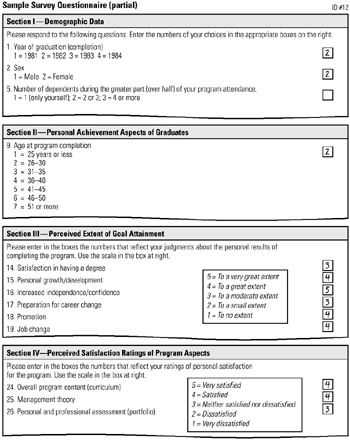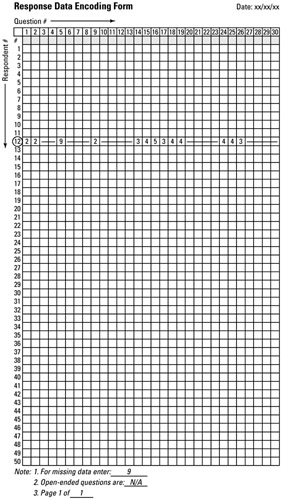Tool 164: Response Data Encoding Form
| AKA | Data Entry Form, Data Matrix |
| Classification | Data Collecting (DC) |
Tool description
The response data encoding form can be viewed as a data matrix that contains transcribed response choices from data collection instruments. It serves as a data entry form, data source for a respondent's profile, and data consolidation sheet.
Typical application
-
To serve as a recording sheet to hold survey data summarized for data entry into the statistical testing process.
-
To sort and record survey data on a data matrix that displays respondents' identification numbers (rows) by response choice variables (columns).
Problem-solving phase
| Select and define problem or opportunity | |
| → | Identify and analyze causes or potential change |
| Develop and plan possible solutions or change | |
| Implement and evaluate solution or change | |
| → | Measure and report solution or change results |
| Recognize and reward team efforts |
Typically used by
| 1 | Research/statistics |
| Creativity/innovation | |
| 6 | Engineering |
| Project management | |
| Manufacturing | |
| 4 | Marketing/sales |
| 2 | Administration/documentation |
| 5 | Servicing/support |
| 3 | Customer/quality metrics |
| Change management |
before
-
Data Collection Strategy
-
Questionnaires
-
Surveying
-
Interview Technique
-
Observation
after
-
Demographic Analysis
-
Survey profile
-
Audience Analysis
-
Presentation
-
Polygon Overday
Notes and key points
-
Each form can accommodate 50 respondents' data for a maximum of 30 questions.
-
Enter the digit 9 for any missing response.
Step-by-step procedure
-
STEP 1 Sort all returned data collection instruments by identification number, or write identification number on instruments. See example Sample Survey Questionnaire (partial), ID #12.
-
STEP 2 Starting with respondent 1 of questionnaire 1, transfer all recorded response choices to the appropriate row and columns on the response data encoding form. In this example, respondent 12 data is recorded as shown. The row shows partial data—see questionnaire items.
-
STEP 3 Verify that all data has been accurately transcribed. Record a 9 for any missing response choices.
-
STEP 4 Date the response data encoding form
Example of tool application

Example of tool application

EAN: 2147483647
Pages: 326